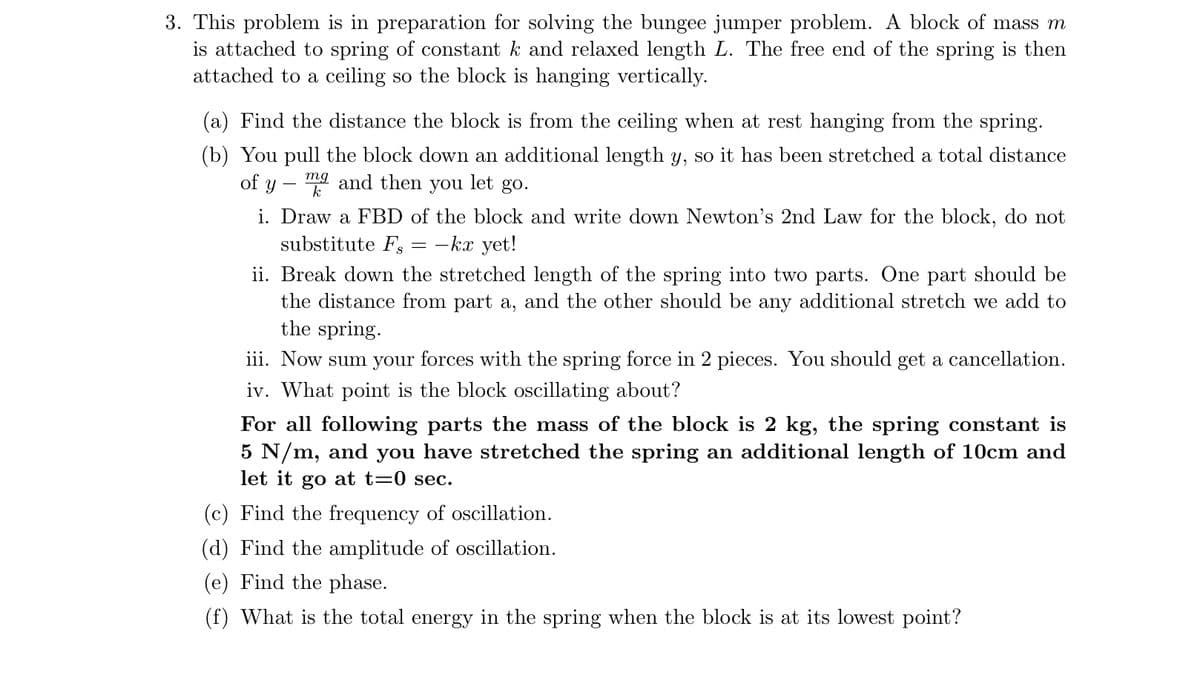3. This problem is in preparation for solving the bungee jumper problem. A block of mass m is attached to spring of constant k and relaxed length L. The free end of the spring is then attached to a ceiling so the block is hanging vertically. (a) Find the distance the block is from the ceiling when at rest hanging from the spring. (b) You pull the block down an additional length y, so it has been stretched a total distance of y - ma and then you let go. i. Draw a FBD of the block and write down Newton's 2nd Law for the block, do not substitute F, = -kx yet! ii. Break down the stretched length of the spring into two parts. One part should be the distance from part a, and the other should be any additional stretch we add to the spring. iii. Now sum your forces with the spring force in 2 pieces. You should get a cancellation. iv. What point is the block oscillating about? For all following parts the mass of the block is 2 kg, the spring constant is 5 N/m, and you have stretched the spring an additional length of 10cm and let it go at t=0 sec. (c) Find the frequency of oscillation.
3. This problem is in preparation for solving the bungee jumper problem. A block of mass m is attached to spring of constant k and relaxed length L. The free end of the spring is then attached to a ceiling so the block is hanging vertically. (a) Find the distance the block is from the ceiling when at rest hanging from the spring. (b) You pull the block down an additional length y, so it has been stretched a total distance of y - ma and then you let go. i. Draw a FBD of the block and write down Newton's 2nd Law for the block, do not substitute F, = -kx yet! ii. Break down the stretched length of the spring into two parts. One part should be the distance from part a, and the other should be any additional stretch we add to the spring. iii. Now sum your forces with the spring force in 2 pieces. You should get a cancellation. iv. What point is the block oscillating about? For all following parts the mass of the block is 2 kg, the spring constant is 5 N/m, and you have stretched the spring an additional length of 10cm and let it go at t=0 sec. (c) Find the frequency of oscillation.
Related questions
Question
3

Transcribed Image Text:3. This problem is in preparation for solving the bungee jumper problem. A block of mass m
is attached to spring of constant k and relaxed length L. The free end of the spring is then
attached to a ceiling so the block is hanging vertically.
(a) Find the distance the block is from the ceiling when at rest hanging from the spring.
(b) You pull the block down an additional length y, so it has been stretched a total distance
of y
mg and then
you
let
go.
i. Draw a FBD of the block and write down Newton's 2nd Law for the block, do not
substitute Fs
-kx yet!
%3D
ii. Break down the stretched length of the spring into two parts. One part should be
the distance from part a, and the other should be any additional stretch we add to
the spring.
iii. Now sum your forces with the spring force in 2 pieces. You should get a cancellation.
iv. What point is the block oscillating about?
For all following parts the mass of the block is 2 kg, the spring constant is
5 N/m, and you have stretched the spring an additional length of 10cm and
let it go at t=0 sec.
(c) Find the frequency of oscillation.
(d) Find the amplitude of oscillation.
(e) Find the phase.
(f) What is the total energy in the spring when the block is at its lowest point?
Expert Solution
This question has been solved!
Explore an expertly crafted, step-by-step solution for a thorough understanding of key concepts.
This is a popular solution!
Trending now
This is a popular solution!
Step by step
Solved in 5 steps with 1 images
